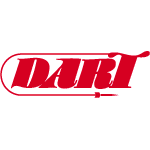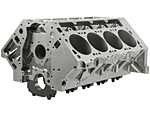

PURCHASER TO RECEIVE:
One custom DART LS Next professionally balanced and assembled short block. This short block ships fully balanced and machined and professionally assembled with Coated Dart cam bearings and brass freeze plugs installed.
NEW PARTS USED IN THIS BUILD AT THE BUY IT NOW PRICE:
One new DART Next block (Choose Bore Size)
One New Molnar Technologies 4340 Forged Crankshaft (Choose Stroke/Choose Reluctor 24x or 58x) Rated to 1200hp (Upgrade to 1500-2000hp rated crank)
Molnar 4340 Billet H-rods w/ 7/16 ARP 2000 rated to 1200hp (Upgrade to 1500-2000hp rated rods)
New Custom Racetec/Autotec Forged Pistons (Ugrade piston and wrist pin for nitrous or boost)
New Total Seal Rings (Upgrade to Boost or Nitorus/Rings)
New King XP Tri-metal Coated Rod and Main Bearings
New Dart Coated LS Cam Bearings
IMPORTANT: CAMSHAFT SHOWN IN EBAY PHOTOS IS NOT INCLUDED AT THE BUY
IT NOW PRICE. EBAY PHOTOS ARE FOR ILLUSTRATIVE PURPOSES ONLY! BILLET
OIL PAN RAIL SHOWN IN EBAY PHOTO IS NOT INCLUDED AT THE BUY IT NOW
PRICE. FREE SHIPPING IS ONLY TO BUSINESS ADDRESS, LIFT GATE AND/OR
RESIDENTIAL IS $195 ADDITIONAL.
Contact Jerry (785) 408-2911 with questions or message through Ebay.
Please see our website and take our shop tour to see the kind of work we do. Thank you and look forward to hearing from you.
Jerry Long, Div Mngr
SAG Performance Group
Phone: (785) 408-2911
Fax: (877) 309-1271
Website: http:/www.sagperfomance
SEE BELOW FOR A WEALTH OF INFORMATION ON THE NEW DART NEXT BLOCK:

Features:
| Reduced windage and increased power
Extended cylinder barrel length
Siamese cylinder bores
Special RMR Iron Alloy
4.000'' or 4.125'' w/ 4.200'' Maximum Bore
4.200'' x 4.100'' Maximum Bore & Stroke
454 Cubic Inch Maximum
Stock LS Camshaft Position
Accepts Standard Camshaft Belt Drive or Chain Drive (Cloyes p/n 9-3658TX3)
1.565'' O.D. Camshaft Snout
.275'' Cylinder Wall Thickness @ 4.185'' Bore
9.240'' Deck Height w / extended cylinder barrels .375'' at bottom
5/8'' (.625'') Deck Thickness
1.500'' Diameter Freeze Plugs
Cam retaining plate: Dart cam retaining plate / Cover. Dart 301-32226000
Billet Steel 4-Bolt Splayed Main Caps w/Center Thrust
.8427'' - .8437'' Lifter Bores (up to .937'' keyed w/ 1.062'' dia. bushing)
Low Volume Priority Main Oiling System w/Center Crossover
Melling or Stock LS Oil Pump
Must Use Remote Oil Filter
Special Oil Pan Required: Moroso, Canton and Stef's
Stock LS style Rear Main Seal with Factory Cover
Factory LS Starter w/Driver and Passenger Mounting Options
Main Bolts: Inners - 7/16'' x 3.600''; Outer - 7/16'' x 2.900''
Studs Holes: Head 10-bolt Pattern with 7/16'', 3/8'', and 8mm sizes
Stud Length in Block: 1.000'' Thread Depth
Factory LS Timing Cover and Front Seal
227 lbs w/Main Caps
100% Made in the USA! |
The New Dart LS Next Engine Blocks are designed to
eliminate the high RPM power loss and the problem of separate bays in
the crankcase associated with the ''Y-Block'' design of the LS engine
series. This has been accomplished by using the conventional style small
and big block Chevy 4-bolt steel main caps with 7/16" bolts, full main
webbing and crank barrel around a standard LS rotating assembly for
maximum bottom end strength!
The cylinder barrels are extended by .375" at the bottom, providing the
effective equivalent of a 9.615" deck height in terms of potential
supported piston travel, while maintaining a standard 9.240" actual deck
height for maximum compatibility with available components. This
equates to greater piston support with long stroke combinations and
allows for better piston designs to increase stability. While extra
thick Siamese cylinder bores allow for large displacement capacity!
The oiling system has also been revised the stock internal main oil
galley has been eliminated and a revised low restriction priority main
oiling system is utilized. A pro-stock / pro-mod big block style stepped
main oil galley measuring 9/16"-1/2"-7/16" is employed and increases
volume but most importantly there is no loss of pressure or velocity at
the front of the block!
At the top end of the block a 5/8" thick full deck design with six head
bolts per cylinder is utilized to provide secure clamping strength and
versatility for power adder applications. LSX style lifter bosses and
guides are utilized while the provisions for oil restrictors in the
lifter valley simplify the installation and removal of restrictors!
Dart’s LS Next Block Performs Well In Oil-system Tests

Dart’s new LS Next iron cylinder block is one step closer to hitting
the market following a series of oil-system tests. The block was first
shown at the SEMA show last November, and it’s designed to take
advantage of the LS engine’s positive attributes while removing the
negatives from the equation. Basically, the new block supports LS
cylinder heads and other major components but replaces the troublesome
Y-block side skirts with Gen I-style main caps and oil-pan rails. The
result is less crank windage and stronger main web.
 The
oiling system was the most critical issue that company founder Richard
Maskin and his team tackled during the block’s development. The first
test used an external pump and a modified Moroso Rocket-block pan core.
The second test utilized a stock LS oil pump, which was modified with a
weaker pressure spring, and a Moroso LS oil pan with pan rail spacers to
make up the difference in the skirt length. These adjustments
maintained the oil desired oil pressure in the engine without the
excessive volume that the LS often requires.
The
oiling system was the most critical issue that company founder Richard
Maskin and his team tackled during the block’s development. The first
test used an external pump and a modified Moroso Rocket-block pan core.
The second test utilized a stock LS oil pump, which was modified with a
weaker pressure spring, and a Moroso LS oil pan with pan rail spacers to
make up the difference in the skirt length. These adjustments
maintained the oil desired oil pressure in the engine without the
excessive volume that the LS often requires.
“According to my sources, the stock LS7 uses somewhere around 18
gallons per minute revved up, while our design uses much less and still
provides more-than-adequate oiling across the board,” explains Maskin.
“So far, we’ve created two blocks – the first one was cut up for
inspection, and the block used for this test was number two. Now that
the initial testing has been run, we plan to pour 25 production blocks
next week, which will be available for purchase on or about the first of
May.
“We’ve got two more tests to run,” continues Maskin. “The first being
a Pro Stock dry-sump system with 25 inches or more of vacuum to see
what power potential is really in the oiling system. For the second
test, we’ll be going back to the stock pump with an all-out, baffled,
screened, wet-sump oil pan.”
More power than expected
The test engine was fitted with Dart’s CNC-machined LS1 heads, a “reasonably small” solid-roller cam, GM intake and 850cfm carb.
“As far as performance goes, there are plenty of performance parts
out there – heads, manifolds, etc. that are much better than what we
used in this engine,” says Maskin. “We were just trying to prove that
the block worked as it was designed to work.”
Experts at Lingenfelter Performance and Nickens Racing Engines had
earlier suggested to Maskin that the engine with those parts would make
about 640 to 660 horsepower. As indicated by the dyno results below, the
engine hit a peak of 740 horsepower and averaged 701 horsepower from
5,600 to 8,000 rpm.

 Dart’s
new LS Next block features 4-bolt steel main caps with 7/16-inch bolts
and full main webbing for maximum bottom-end strength. The cylinder
barrels are .375-inch longer for better piston support and ring seal. It
comes with a 9.240-inch deck height and 5/8-inch deck thickness. The
siamesed cylinder bores can be opened up to 4.200 inches, allowing for
large-displacement options.
Dart’s
new LS Next block features 4-bolt steel main caps with 7/16-inch bolts
and full main webbing for maximum bottom-end strength. The cylinder
barrels are .375-inch longer for better piston support and ring seal. It
comes with a 9.240-inch deck height and 5/8-inch deck thickness. The
siamesed cylinder bores can be opened up to 4.200 inches, allowing for
large-displacement options.
The block also features blind head bolts: four 7/16-inch head bolts,
one 3/8-inch and one stock-sized inner hole per cylinder to improve
clamp force in power-adder applications. There are provisions for oil
restrictors in the lifter valley to complement the low-volume, priority
main oiling system. LSX-style lifter bosses and dog-bone provisions are
also included with the LS Next block – it will easily accommodate
1.060-inch bushings with .937-inch lifters. The block also features a
Pro Stock/Pro Mod-type big-block style stepped main oil galley. Lastly,
the water jacket around the No. 1 cylinder has been expanded as well as
around the outside of each cylinder barrel for additional cooling
capacity.
 Test Engine Specs:
Test Engine Specs:
- Bore: 4.155 inch
- Stroke: 4.00 inch
- Rod Length: 6.125 inch
- Compression Ratio: 12.5:1
- Pistons: Mahle flat top
- Engine Bearings: Clevite
- Camshaft: Mechanical roller 255/265 duration, .670-inch lift
- Rocker: Harland Sharp Roller
- Heads: Dart w/ 2.08-inch I/1.60-inch E
- Intake: Chevy Performance single plane
- Carburetor: Demon 850cfm
- Ignition: HEI, with 30 degrees timing
- Oil Pump: Moroso external, Melling stock replacement
- Oil Pan: Moroso
- Headers: Hedman
Check out this interview with Richard Maskin from the 2012 PRI show as he discusses the LS Next block.
http://www.enginelabs.com/news/darts-ls-next-block-performs-well-in-oil-system-tests/
 8 del west 7mm .060 thick lash caps nascar arca aussie supercar nhra(US $30.00)
8 del west 7mm .060 thick lash caps nascar arca aussie supercar nhra(US $30.00) Edelbrock 77485 cylinder head cyl head vic jr bbc 24 deg rec port(US $1,368.26)
Edelbrock 77485 cylinder head cyl head vic jr bbc 24 deg rec port(US $1,368.26) Dart iron eagle small block chevy cylinder head 200-72-angle plug pn 10410010p(US $273.90)
Dart iron eagle small block chevy cylinder head 200-72-angle plug pn 10410010p(US $273.90) Dart iron eagle small block chevy cylinder head 215-72-angle plugs pn 10610020p(US $273.90)
Dart iron eagle small block chevy cylinder head 215-72-angle plugs pn 10610020p(US $273.90) Dart pro1 small block chevy cylinder head 180-72-straight plug pn 11220010p(US $384.95)
Dart pro1 small block chevy cylinder head 180-72-straight plug pn 11220010p(US $384.95) Brian crower bc8208 head gasket for honda s2000 f20c f22c 88mm bore bc8208(US $126.58)
Brian crower bc8208 head gasket for honda s2000 f20c f22c 88mm bore bc8208(US $126.58)










